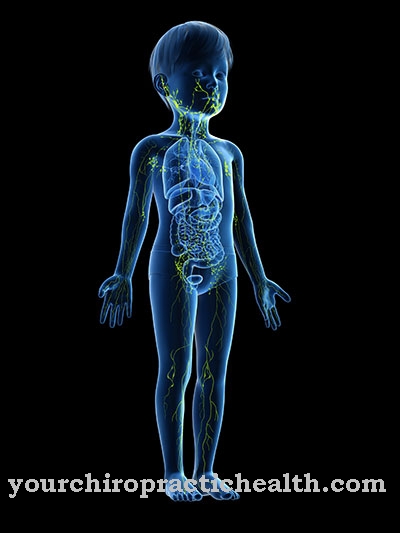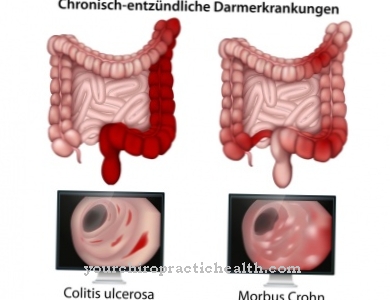Multiple cartilaginous exostoses are multiple and hereditary exostoses. The benign bone tumors are based on an autosomal dominant hereditary mutation. The treatment consists largely of surgical removal of the tumors.
What are multiple cartilaginous exostoses?

© lenetsnikolai - stock.adobe.com
Exostoses lead to a delimited new formation of compact bone substance that is directed outwards. Exostoses are hyperostoses, i.e. hyperplasias of the bone tissue, which are characterized by an increase in the number of cells. Most of the time, exostosis is a hyperplastic reaction. The bone changes in response to stimuli such as pressure.
In still other cases, exostosis is a benign tumor disease associated with the formation of osteomas and characterized by slow growth. There are also hereditary exostoses. An associated disease is that multiple hereditary exostosis, MHE for short.
It is an autosomal dominant inherited disease with multiple, benign bone tumors, also known as multiple cartilaginous exostoses are known. Although it is a congenital disease, the tumors are usually not present at birth.
The development usually begins in childhood or adolescence and corresponds to a slowly progressing development. The tumors are osteochondromas with hyaline cartilage. The incidence of the disease is given as one case in 50,000 people. With this frequency, the disease is one of the most common exostotic diseases, affecting women and men equally frequently.
causes
Multiple hereditary exostoses are an inherited disease for which familial accumulation has been observed. Around 70 percent of all patients have a familial form that is passed on as an autosomal dominant inheritance. The disease occurs sporadically in only about 30 percent of cases. The causes of the phenomenon can be found in genetics.
Hereditary mutations are present in the majority of all cases. In the sporadic proportion of those affected, the disease corresponds to a new mutation that is probably related to exogenous factors such as environmental toxins. The causative mutations for multiple hereditary exostoses have now been identified. These are mutations in the genes EXT1 and EXT2 on chromosome 8 and chromosome 11.
In the DNA, these genes code for the proteins exostosin 1 and exostosin 2. The two proteins are so-called glycosyltransferases, which modify heparan sulfate within the Golgi apparatus. Heparan sulfate is a proteoglycan involved in angiogenesis.
As a result of the mutations, the proteins used to modify this substance are not put together correctly. How this mutation and the loss of function of enzymes are associated with bone tumor development remains unclear.
Symptoms, ailments & signs
The clinical picture of patients with multiple hereditary exostoses is extremely variable. In many cases the disease is asymptomatic. Clinically manifest cases are characterized by uncontrolled exostotic growth that takes place near the growth plate of bone ends and is covered with cartilage.
The bones deform, causing the legs, arms, hands, feet, toes or fingers to grow unevenly. The multiple exostoses can lead to restricted mobility. Generalized short stature is also a possible consequence. Some patients complain of pain, which is mostly associated with nerve compression.
There are different clinical courses for the disease. According to Pedrini, the MHE is divided into three parts:
- In class 1, the tumors do not cause any deformities and neither do any functional restrictions, since there are usually fewer than five exostoses.
- Class 2 of multiple cartilaginous exostoses is associated with deformities, but no functional restrictions.
- Class 3 deformities with functional limitations.
How many exostoses there are varies from case to case. This means that the accompanying pain and impairment symptoms are extremely variable.
Diagnosis & course of disease
The bone tumors of multiple cartilaginous exostosis are absent at birth, so the diagnosis is typically not made until the age of 12. Since the exostoses in many cases result in neither pain nor impairment, a later diagnosis is also conceivable. Diagnostics focus on imaging methods such as X-ray imaging, with a biopsy usually being taken to assess the tumors.
The histological analysis proves the benign nature of the tumors. In case of doubt, a molecular genetic analysis can be carried out to provide evidence of the causal mutations. However, this analysis is sometimes very complex. The patient's prognosis depends on the severity of the disease in each individual case. In the case of a strong exostosis, the therapy results are often unsatisfactory.
Complications
In most cases, people affected by this disease suffer from very severe restrictions on movement. As a rule, there is also a short stature, which has a very negative effect on the quality of life of the patient. Furthermore, there may be restrictions in everyday life, so that the person affected is dependent on the help of other people in everyday life.
It is not uncommon for pain to occur that continues to affect everyday life. Those affected also suffer from sleep problems and insomnia if the pain also occurs at night in the form of resting pain. In most cases, early diagnosis and treatment are not possible. However, since the tumors are usually benign, they do not pose any particular health risk in the first place.
For this reason, treatment usually only takes place if the disease leads to severe restrictions or pain in everyday life. There are no particular complications and there is no reduction in life expectancy. However, in many cases the patients are dependent on physiotherapy.
When should you go to the doctor?
Swelling or growth on the bones is unusual. If they occur after a bruise or a fall, spontaneous healing can often occur. If the symptoms have disappeared after cooling down or a sufficient night's sleep, a doctor is usually not needed. If the irregularities persist or if they increase in intensity, a doctor should be consulted, as there is an illness that requires treatment.
If there are movement disorders, general mobility restrictions or joint problems, a doctor is required. If pain occurs, there is an increased need for action. The independent intake of pain medication is generally not recommended. Due to possible risks and side effects, medication should only be given in consultation with the attending physician.
Deformations of the bone structure, poor posture and muscle tension should be examined by a doctor. A doctor is required if participation in social and societal life falls due to the complaints, if everyday obligations can no longer be fulfilled or if usual sporting activities can no longer be performed.
Inner restlessness, behavioral problems, changes in the appearance of the skin and sleep disorders should be examined and treated. Emotional and psychological stress, fear or significant changes in weight are signs of impaired health. The person concerned needs medical help so that the symptoms can be alleviated.
Treatment & Therapy
As long as multiple cartilaginous exostoses show no symptoms, treatment of the patient is not absolutely necessary. A causal treatment cannot take place anyway, since the genetic mutation is irreversible. This means that only symptomatic treatment options are available for patients with hereditary exostoses.
These therapeutic approaches are usually only carried out if the exostoses impair the patient's mobility and everyday life or if severe pain restricts the patient's quality of life. In such cases, the exostoses are removed invasively and surgically. The surgeon is generous with this procedure.
The more it removes, the less likely it is to recur. If the exostoses in old age favor secondary diseases such as osteoarthritis, the use of prosthetic joints may be necessary. If there are extreme pain symptoms, the patient's quality of life may be improved with pain relieving medication. In some cases, physical therapy is used to combat the restricted mobility.
Outlook & forecast
The prognosis for multiple cartilaginous exostoses varies. It depends on the willingness of the benign tumor to grow and the individual complaint situation. The disease usually accompanies patients throughout their lives. Follow-up checks take place regularly. This can represent a psychological burden because of the incalculability of the occurrence of the disease. In the worst case, those affected suffer restrictions in their quality of life. Everyday life is characterized by pain and difficulty moving. Because of the possible malignant degeneration, the multiple cartilaginous exostoses can also shorten the life span. Statistically, this occurs in five percent of all cases.
The disease is diagnosed in roughly equal proportions in both sexes. Most patients are still children when they are diagnosed and are twelve years old. The multiple cartilaginous exostoses cease to develop at the end of the physical growth phase. If they continue to grow in adulthood, this speaks for a malignant degeneration and thus an unfavorable prognosis.
In therapeutic practice it appears problematic that multiple cartilaginous exostoses form recurrences. Therefore, surgical interventions often lead to unsatisfactory results. This is also due to the fact that many patients have over twenty exostoses.
prevention
Multiple cartilaginous exostoses are hereditary exostoses. For this reason, genetic counseling in the family planning phase is one of the few ways to prevent the disease. However, the occurrence cannot be completely ruled out when deciding against having one's own children, as new mutations could lead to the disease.
Aftercare
When the growth is complete, the development of new exostoses usually ends, so that the disease does not worsen from this point on. Even if all functional restrictions have been eliminated through physiotherapy and surgical interventions, regular checks should still be carried out. If an exostosis continues to increase in size or if a new one arises, this is an indication of a degeneration that requires renewed treatment.
Some of the consequences of multiple cartilage exostoses accompany the patient for a lifetime. Leg length differences or axis deviations in the joints must be treated consistently with orthotics and physiotherapy in order to prevent secondary diseases such as osteoarthritis or other signs of wear and tear. In general, an active lifestyle with regular exercise is recommended.
This preserves the mobility of restricted joints, sometimes even improves it. In the case of severe restrictions, joint-friendly sports such as swimming or walking are indicated. Strength training strengthens the muscles, which serve as support for deformed joints and thus relieve them.
The psychological consequences of multiple cartilage exostoses should also not be underestimated. Because they are different, children in particular often experience exclusion and bullying. Psychotherapy adapted to the symptoms or attending self-help groups can help to gain positive experiences.
You can do that yourself
Surgical corrections are contraindicated until the end of puberty and the growth phase, as they trigger even stronger bone growth and thus deterioration.
Relatives have various options to alleviate illness-related symptoms up to this point. Intensive physiotherapy and medical massages prove to be soothing even with significant restrictions on movement and can under certain circumstances make the symptoms disappear completely. The exercises used can also be continued in the home environment.
In order to achieve an improvement in the quality of life, the pain and the associated lack of sleep must first and foremost be combated. Mattress covers and chair covers provide good padding and take the pressure off the painful over-legs. Many sufferers also suffer from a significant worsening of their symptoms in the colder season. Warming gel packs, hot water bottles or special heat-storing heating pads provide quick relief. With smaller children, warm cuddly toys for the microwave have also proven themselves. It is not advisable to use electrically operated heating blankets, as these harbor the risk of overheating and can lead to home fires.
Parents must ensure that children are given the prescribed painkillers at school if necessary. Ideally, these are placed directly in the classroom. A table in which every intake is briefly documented helps to avoid an overdose.





.jpg)







.jpg)

.jpg)
.jpg)











.jpg)